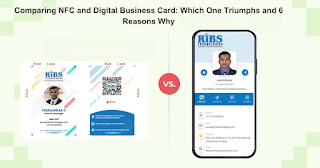Comparing NFC and Digital Business Card: Which One Triumphs and 6 Reasons Why
In today's digital era, the traditional paper business card is gradually making way for its modern counterparts: the NFC Business Card and the Digital Business Card. But which one stands out as the top choice? In this article, we delve into the unique features of both and present 6 compelling reasons that determine their supremacy.
Introduction to NFC Business Card
NFC Business
Card leverages Near Field Communication (NFC) technology. By tapping
the card onto an NFC-enabled device, such as a smartphone, one can
instantaneously share contact information or a digital profile.
Benefits:
- Instant
Sharing: Just a tap can transfer your business details to another's
device.
- Physical
Touchpoint: While it's digital, there's still a tangible card
involved, bridging the gap between traditional and modern methods.
- Customizable
Digital Profile: You can link your card to a dynamic online profile
that can be updated anytime.
Introduction to Digital Business Card
A Digital Business
Card is essentially a digital file or link that contains your
professional details. It can be shared via QR codes, email, messaging apps, or
social media.
Benefits:
- Eco-Friendly:
No paper or physical material is used.
- Easy
to Update: Changes to your job title or contact info? Just update your
card online.
- Wider
Reach: Easily shared globally without geographical constraints.
Comparing NFC and Digital Business Cards: 6 Reasons Why
One Might Triumph
- Sustainability:
Digital Business Card has an edge when it comes to environmental concerns.
Being completely electronic, they reduce the need for paper and the
subsequent waste.
- Convenience:
While both types allow for seamless sharing, the NFC Business Card
requires a physical card to tap. On the other hand, a Digital Business
Card can be shared remotely, giving it a slight advantage in terms of
convenience.
- Device
Dependency: NFC Business Card requires the recipient to have an
NFC-enabled device, whereas Digital Business Card can be shared and viewed
across multiple platforms and devices.
- Cost:
Producing an NFC Business Card might come with an additional cost due to
the NFC chip embedded. Digital Business Cards, often offered by online
platforms, might come with a subscription fee but no physical production
cost.
- Memorable
Interaction: Tapping an NFC Business Card to a phone can create a
memorable interaction, making it a unique experience for the recipient
compared to just receiving a link.
- Versatility:
With the increasing number of digital platforms available, Digital
Business Cards can be shared across various channels, from emails to
social networks. This provides a broader reach compared to the
tap-to-share method of NFC cards.
Conclusion
Both NFC Business Card and Digital Business Card offer
innovative solutions to networking in the digital age. The choice between the
two boils down to individual preferences, business needs, and the target
audience. While the NFC Business Card offers a unique tactile experience, the
Digital Business Card shines in terms of versatility and sustainability.
Choose wisely based on your unique professional needs and
keep abreast of evolving technologies in this domain.




Comments
Post a Comment